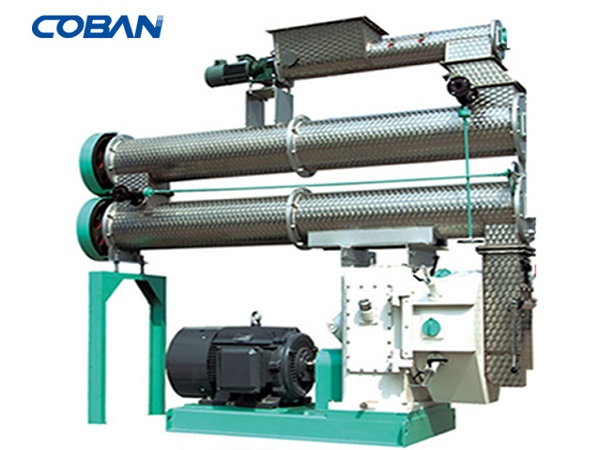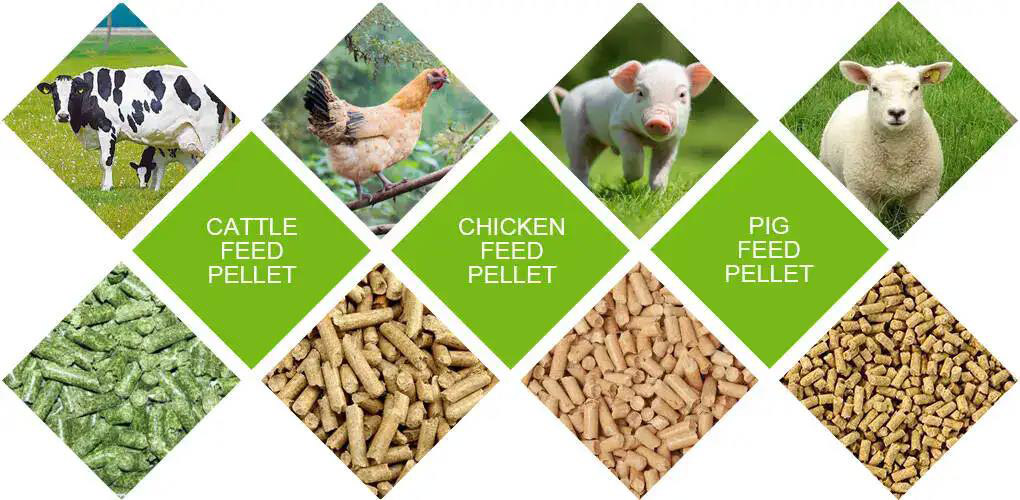animal feed pellet machine
animal feed pellet machine is a mechanical device specialized in processing animal feed, which mixes raw materials and compresses them into
animal feed pellet machine Introduction
The animal feed pellet machine is a mechanical device specialized in processing animal feed, which mixes raw materials and compresses them into various sizes and shapes of pellets. These pellet feeds typically have uniform size, shape, and balanced nutritional content, making them easier to store, transport, and consume. The animal feed pellet machine plays a crucial role in the livestock industry by producing feed suitable for the growth requirements of various animals such as poultry, livestock, and aquaculture.


Features of animal feed pellet machine
Efficient Pelletizing
Utilizes precision molds and roller designs to compress uniformly mixed powdered feed into dense, consistent pellets, enhancing nutritional value and digestibility.(Similar news:What Are The Functions Of Animal Feed Pellet Machine>>)
Adaptive Pressure Adjustment
Advanced models feature pressure-sensing systems that automatically adjust compression force based on the hardness of different raw materials, ensuring consistent pellet quality across various formulations and conditions.
Intelligent Temperature Control
Equipped with built-in heating or cooling systems, actively regulating the heat generated during compression to maintain optimal pelletizing temperatures, prevent nutrient degradation, and facilitate smooth pellet formation.
Automatic Lubrication System
Designed with automatic lubrication devices to reduce wear and maintenance requirements, providing timely lubrication to critical rotating components and prolonging machine lifespan while minimizing downtime for maintenance.
Fault Self-Diagnosis
Integrated electronic control systems with fault detection and warning functions can actively identify potential operational issues such as overload or blockage, alerting operators for timely intervention and minimizing downtime due to malfunctions.
Formula Memory and Adjustment
High-end models may feature memory functions capable of storing multiple feed formulations, allowing for quick retrieval or modification of recipes as needed, thereby enhancing production flexibility and efficiency.
Environmental Sustainability
Optimized energy designs, such as efficient motors and energy-saving transmission systems, reduce power consumption, while also minimizing noise pollution, aligning with green production requirements.
Ease of Cleaning and Maintenance
Designed for easy cleaning and maintenance with features like quick-disassembly components and cleaning channels, facilitating regular cleaning to maintain equipment hygiene and prevent cross-contamination.
Modular Design
Some models adopt modular structures, enabling the addition or removal of functional modules according to production needs, such as adding cooling modules for rapid cooling of freshly formed hot pellets or adjusting preprocessing modules based on raw material characteristics, enhancing equipment adaptability and scalability.


Structure of animal feed pellet machine
Feeding System
This system is responsible for conveying raw materials into the pellet machine for processing. It typically includes a feeding device and a feeding inlet.
Compacting System
The compacting system comprises rollers, dies, and pressure adjustment devices, which are used to compress the raw materials into pellet shapes. The design and adjustment of the compacting system are crucial for the shape and quality of the pellets.
Cutting System
This system is used to cut the pellets to the desired length after they are compacted. It usually includes cutting knives or cutting wheels.
Cooling System
Pellets often exit the compacting system at elevated temperatures. The cooling system is employed to reduce the temperature of the pellets, preventing deformation or deterioration due to high temperatures.
Vibrating Screening System
This system is used to screen out pellets that meet the specifications, removing oversized or undersized pellets to ensure product quality.
Collection and Packaging System
This system collects the pellets that meet the requirements and packages them. It includes collection devices, conveying equipment, and packaging machinery.


Advantages of animal feed pellet machine
To improve feed digestibility
The pelletization process increases the density of the feed, improving its physical structure and aiding better digestion and nutrient absorption by animals.
To reduce feed wastage
Pelleted feed is more resistant to wind and rain erosion compared to powdered feed, reducing losses during storage and feeding.
For easy storage and transportation
Pelleted feed occupies less space, facilitating long-term storage and offering convenience and economy during transportation.
For automated production
Modern pelletizers are typically equipped with automated control systems, reducing manual intervention and enhancing production efficiency.
High flexibility
Feed formulas can be adjusted according to the nutritional requirements of different animals and growth stages, enabling the production of various types of pelleted feed.
Hygienic safety
The heating process during pelletization can kill pathogens and pests in the raw materials, enhancing the hygienic safety of the feed.
To enhance feed quality
Precise control over the pelletizing process ensures the production of consistent-quality feed products.
Cost savings
By reducing waste and improving feed conversion rates, pelletization can lead to long-term cost savings for farmers.
Versatility in raw material usage
Various feed ingredients such as grains, legumes, grass powders, and by-products from the food industry can be utilized.
To boost market competitiveness
High-quality pelletized feed can enhance the market competitiveness of products from livestock farms.
Customizability
Pelletizers can be customized according to customer requirements to meet specific production needs.
Application of animal feed pellet machine
Typically, the production of horse feed pellet machine uses raw materials such as corn, soybeans, wheat, and other nutrients as the formula. Our feed pellet machine are specially used to produce feed for poultry, livestock, pigs, horses, cattle, sheep, chickens, ducks, goose and other animals.For different animals, with different growth cycles, (chicks, suckling pigs, calves, etc.), the feed pellet size required is different, but our feed production line only needs to replace ring molds with different apertures or use a pellet crumbler to reach the required size.

Parameter of animal feed pellet machine
| Model | Capacity | Main Motor Power | Feeder Motor Power | Conditioner Power | Dia. of Ring Die | Pellet Size |
| SZLH250 | 1-2T/H | 22KW | 0.75kw | 1.5kw | 250mm | 2-12mm |
| SZLH320 | 3-4T/H | 37KW | 1.5kw | 2.2kw | 320mm | 2-12mm |
| SZLH350 | 5-7T/H | 55KW | 1.5kw | 3kw | 350mm | 2-12mm |
| SZLH420 | 8-12T/H | 110KW | 1.5kw | 7.5kw | 420mm | 2-12mm |
| SZLH508 | 10-18T/H | 160KW | 2.2kw | 11kw | 508mm | 2-12mm |
| SZLH558 | 15-25T/H | 180KW | 2.2kw | 11kw | 558mm | 2-12mm |
| SZLH678 | 20-30T/H | 220KW | 2.2kw | 11kw | 678mm | 2-12mm |
| SZLH768 | 25-42T/H | 280KW | 2.2kw | 11kw | 768mm | 2-12mm |
After-sale Service
- – HKB provides advanced grain safety storage technology to assure your grain silo 100% quality stability.
- – grain silo Quality guarantee is one year after installation and commissioning or 18 months after leaving China Port. Maturity is the first.
- – 7 days x 24 hours service, within 24 hours reply/solve of any technical issues upon request.
- – Routinely telephone track to remove all might be problems grain silo or issues guarantying the whole system grain silo long-lasting safety and reliability.
- – HKB will consider all other needs like customs clearance, sea delivery, insurance, customs tax benefit plan, documentation, etc. So our respected Users feel so relaxed and easy to get the grain silo system well.







